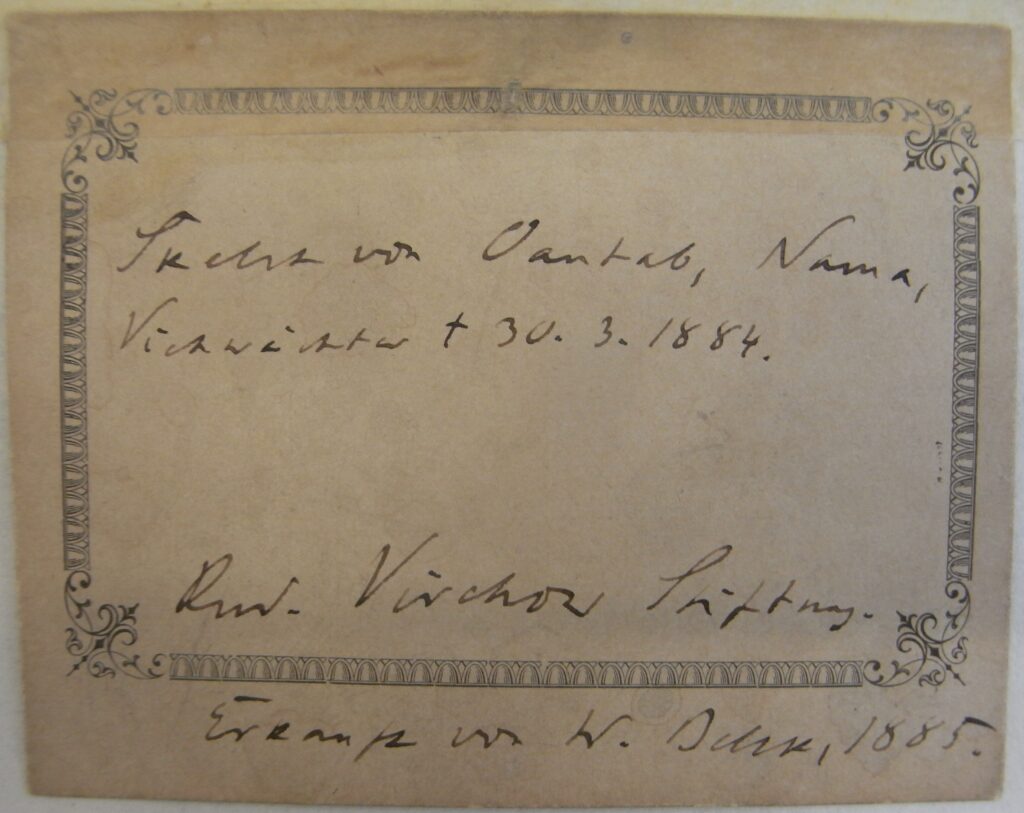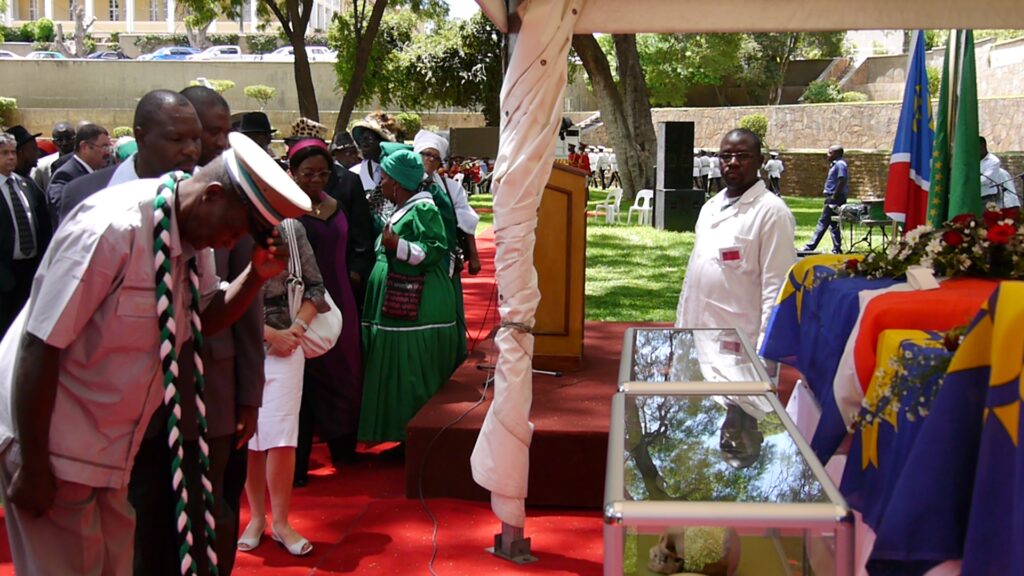by Hans Axasi ǂEichab, Dag Henrichsen, Holger Stoecker & Larissa Förster
Originally Published 26 February 2021 [LINK TO ORIGINAL]
In May 2016 we reported in this newspaper about a grave robbery in the Kuiseb in early December 1884 by the German scientist Waldemar Belck and the shipment of three skeletons from Walvis Bay to Berlin. They belonged to three men, Jacobus Hendrick, Jacobus !Garisib and Oantab with Swartbooi/Topnaar/Damara background. They had died on 30 March 1884 during a cattle raid by the Herero at a place called //Kharabes close to Rooibank. A few weeks later the men had been buried by Kaptein Jan Jonker Afrikaner.
We came across the names and details of the three deceased men in documents from various archives and in publications of the Berlin Society for Anthropology, Ethnology and Prehistory (BGAEU). This Berlin institution still holds the remains of Jacobus Hendrick and Oantab, whilst the bones of Jacobus !Garisib are not preserved. In 2016, we also asked readers of this newspaper to trace and alert us about possible descendants.

We can now report that by publishing key information from the colonial archive in The Namibian and also in Republikein, we were able to get in touch with the Khoekhoegowab-speaking oral historian Hans Axasi ǂEichab, who contacted further family members. It turned out that the stories passed on through family oral histories refer extensively to the conflict-prone history of the Kuiseb region at the end of the nineteenth century. This is partially because this was the reason for the flight and displacement of the family both the Kuiseb (towards Utuseb and Walvis Bay) and into other parts of the country, such as to Rehoboth, Kalkrand, Gobabis, Aranos, Fransfontein, Sesfontein, Khorixas und Outjo. The grave robberies on the lower Kuiseb are also remembered by the family of Hans Axasi ǂEichab, as he recalls:
‘I can vividly recall how my grandmother told us horrific stories about a raid, massacres, rapes, abductions, desecration of the dead, burials and exhumation and exportation of human remains in the lower !Khuiseb over the waters [i.e. sea] to somewhere. … We, then as children took it up just as stories about the mythological Khoegaroen [i.e. maneaters] …, but now I realised that it is my own flesh and blood.’
Furthermore, these memories suggest that the three deceased men also belonged to the kinship network of Hans Axasi ǂEichab’s great-grandmother. Jacobus !Garisib is understood to be the brother of ǂKhoan Garises (1869-1969), and these historical memories were passed down through her daughter, Kappi Garises, and granddaughter, Martha Dama Garises (1914-1995) – the latter being ǂEichab’s mother. Furthermore, Hans Axasi ǂEichab identified some of the recitations passed down in the family as praise poems for the three historical individuals.
As such, our efforts to re-individualise the skeletons of Jacobus Hendrick, Jacobus !Garisib and Oantab and understand their biographies took a significant turn, with more biographical family histories yet to be unearthed.
Recently, Hans Axasi ǂEichab reported to Henrichsen that ‘all the members from the personally affected communities within the ranks of !Ainin, Swartboois and !Naranin descendants are … awaiting a positive solution towards restitution and return of the mortal remains of their loved ones.’ He also noted that the affected families want a monument to be built //Kharabes in the wake of the demanded restitution.
The prospect of the return to Namibia of the remains of Jacobus Hendrick and Oantab awaits serious consideration. So far, the BGAEU has not responded to our various published research interventions [for more information, see our 2018 article in Human Remains and Violence, https://doi.org/10.7227/HRV.4.2.4]. We must also remember that there were forceful demands for the return of Jacobus Hendrick shortly after the grave robbery in late 1884. Belck himself reported that the (unnamed) daughter of Hendrick demanded her father´s remains when hearing in Walvis Bay of the grave robbery. Instead of complying with her demands, Belck gave her the skull of Jacobus !Garisib instead. According to family genealogies, a woman by the name of Anna Hendrick comes into question as the daughter who claimed her father’s remains already in 1884. Today, her restitution-seeking role has been assumed by Hans Axasi ǂEichab together with the relatives of Jacobus Hendrick, Jacobus !Garisib und Oantab.
The BGAEU, in whose ‘possession’ the remains of two of the men are until today, needs thus also to deal with an existing, yet unresolved restitution claim by Jacobus Hendrick’s daughter.

Generally speaking, human remains from the colonial period remain nameless. If the grave robbery in the lower Kuiseb is not a unique case of colonial violence, the re-individualisation of the three men as reported here is very uncommon. It forces us to act and demand the final restitution from a scientific collection in Germany to the Namibian soil in which they already rested, as well as a full acknowledgement of what happened.
If you have any relevant information on the three men named here, their descendants, the raiding incident in 1884, or on the local history of //Kharabes (or also #Arexa!nanis) more generally, please share it with us. Your communication will be treated confidentially. You can phone/write to Hans Axasi ǂEichab 081 882 0928 and Dag Henrichsen dh@baslerafrika.ch
BIOGRAPHICAL NOTE: Hans Axasi ǂEichab is an expert in the history of Khoekhoegowab-speaking people. Dag Henrichsen is Namibian historian at the Basler Afrika Bibliographien in Switzerland. Holger Stoecker is an historian at the Humboldt University in Berlin in Germany. Larissa Förster is a cultural anthropologist and associate researcher at the Humboldt University of Berlin in Germany. All have previously engaged and worked on Namibian history, memory and cultural politics. Here they write in their personal capacity.
